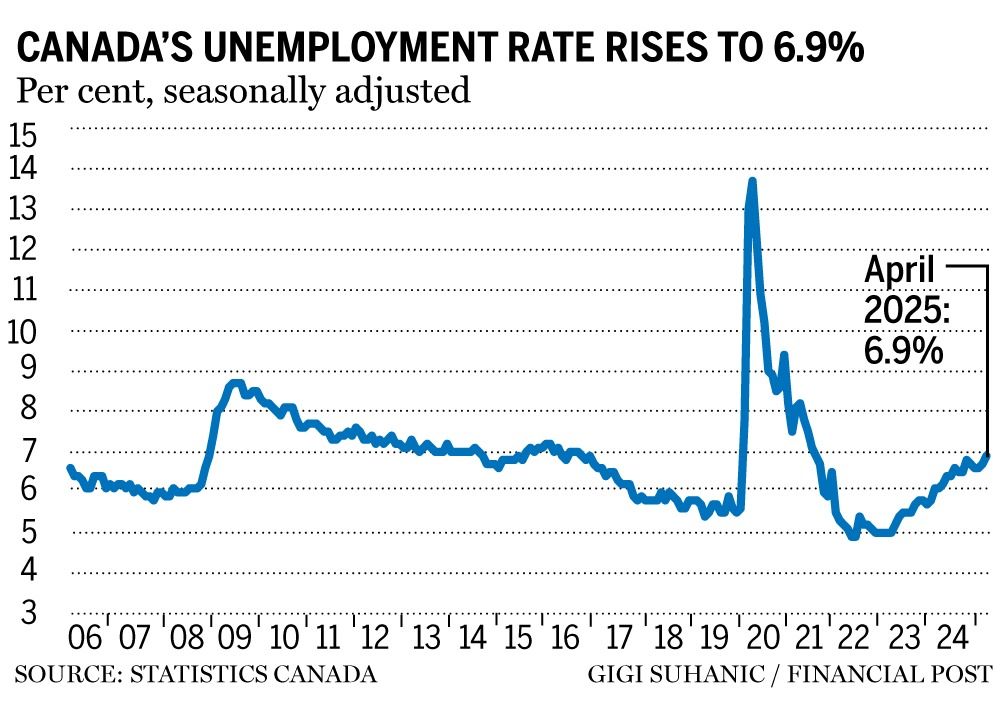Canada’s
unemployment rate
climbed to 6.9 per cent in April, up from 6.7 per cent in March, even though the economy added 7,400 jobs,
Statistics Canada said
on Friday.
Employment in manufacturing fell by 31,000 during the month and employment in wholesale and retail trade also declined by 27,000 jobs, as trade-linked industries continue to feel the uncertainty brought on by
U.S. tariffs on Canadian exports
. The drop in employment in manufacturing was the most significant decline since November 2024. Employment in construction, natural resources and the hospitality sectors were also down in April.
The small overall gain in jobs was outpaced by population growth in April, as the labour participation rate rose by 0.1 per cent to 65.3 per cent during the month, leading to the higher unemployment rate.

The
Bank of Canada
decided to pause its policy rate at 2.75 per cent in April, as policymakers assessed the impact tariffs were having on the Canadian economy.
Economists said Friday’s report is evidence Canada’s job market is already getting hit by trade war uncertainty.
“The weak details of the April job numbers highlight the negative turn the Canadian economy could be facing if trade tensions don’t cool,” said Brendon Bernard, senior economist at Indeed Canada, in a note.
“Conditions were already trending in the wrong direction, and now with the unemployment rate already approaching seven per cent, more months like this would send the labour market to its weakest state (outside the pandemic) in years.”
Among those employed in March, 0.7 per cent became unemployed in April due to a layoff, little changed from the 0.6 per cent recorded last year. The unemployment rate in April was at its highest since January 2017, excluding the COVID-19 pandemic.
Job gains were recorded in public administration, which rose by 37,000 positions, driven by temporary work associated with the federal election. Employment also increased in real estate, finance, insurance, rental and leasing by 24,000 jobs, with the sectors adding 64,000 jobs since October.
Employment in the public sector increased by 23,000 in April, while employment in the private sector was little changed.
Bank of Montreal chief economist Douglas Porter said if it weren’t for the job gains in public administration, headline employment would have been similar to the -30,000 recorded in March.
“It doesn’t take an archeological dig to realize this is a weak report,” said Porter, in a note to clients. “This clearly increases the odds of a 25-basis point rate cut in June.”
David Rosenberg, founder and president at Rosenberg Research & Associates Inc., said the further loosening in the labour market “should be top of mind for the Bank of Canada.”
“All roads here lead to lower rates and a lower Canadian dollar,” he said, in a note.
The number of people looking for work or on temporary layoff rose by 39,000 in April and was up 189,000 on a year-over-year basis. Unemployed people continued to face more difficulties finding work than the previous year. Among those unemployed in March, 61 per cent remained jobless in April, higher than what was witnessed in the same months in 2024 at 57.3 per cent.
Total hours worked increased by 0.4 per cent in April and were up 0.9 per cent on a year-over-year basis, while average hourly wages were up 3.4 per cent.
• Email: jgowling@postmedia.com
Bookmark our website and support our journalism: Don’t miss the business news you need to know — add financialpost.com to your bookmarks and sign up for our newsletters here.
Canada's unemployment rate climbs to 6.9% as tariffs bite
2025-05-09 12:49:53





